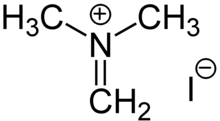
In organic chemistry, an iminium cation is a polyatomic ion with the general structure [RRC=NRR]. They are common in synthetic chemistry and biology.
Structure

Iminium cations adopt alkene-like geometries: the central C=N unit is nearly coplanar with all four substituents. Unsymmetrical iminium cations can exist as cis and trans isomers. The C=N bonds, which are near 129 picometers in length, are shorter than C-N single bonds. Cis/trans isomers are observed. The C=N distance is slightly shorter in iminium cations than in the parent imine, and computational studies indicate that the C=N bonding is also stronger in iminium vs imine, although the C=N distance contracts only slightly. These results indicate that the barrier for rotation is higher than in the parent imines.
Formation
Iminium cations are obtained by protonation and alkylation of imines:
- R'N=CR2 + H → [R'NH=CR2]
- R'N=CR2 + R → [R'RN=CR2]
They also are generated by the condensation of secondary amines with ketones or aldehydes:
- O=CR2 + R'2NH + H ⇌ [R'2N=CR2] + H2O
This rapid, reversible reaction is one step in "iminium catalysis".
More exotic routes to iminium cations are known, e.g. from ring-opening reactions of pyridine.
Occurrence

Iminium derivatives are common in biology. Pyridoxal phosphate reacts with amino acids to give iminium derivatives. Many iminium salts are encountered in synthetic organic chemistry.

Reactions
Iminium salts hydrolyse to give the corresponding ketone or aldehyde:
- [R2N=CR2] + H2O → [R2NH2] + O=CR2
Iminium cations are reduced to the amines, e.g. by sodium cyanoborohydride. Iminium cations are intermediates in the reductive amination of ketones and aldehydes.
Unsymmetrical iminium cations undergo cis-trans isomerization. The isomerization is catalyzed by nucleophiles, which add to the unsaturated carbon, breaking the C=N double bond.
Named reactions involving iminium species
- Aza-Cope rearrangement
- Beckmann rearrangement
- Duff reaction
- Mannich reaction
- Pictet-Spengler reaction
- Stephen aldehyde synthesis
- Stork enamine alkylation
- Vilsmeier-Haack reaction and Vilsmeier reagent
Iminylium ions
Iminylium ions have the general structure R2C=N. They form a subclass of nitrenium ions.
See also
References
- IUPAC, Compendium of Chemical Terminology, 2nd ed. (the "Gold Book") (1997). Online corrected version: (2006–) "iminium compounds". doi:10.1351/goldbook.I02958
- Guido M. Böttger Roland Fröhlich Ernst-Ulrich Würthwein (2000). "Electrophilic Reactivity of a 2-Azaallenium and of a 2-Azaallylium Ion". European Journal of Organic Chemistry. 2000 (8): 1589–1593. doi:10.1002/(SICI)1099-0690(200004)2000:8<1589::AID-EJOC1589>3.0.CO;2-T..
- ^ Johnson, James E.; Morales, Nora M.; Gorczyca, Andrea M.; Dolliver, Debra D.; McAllister, Michael A. (2001). "Mechanisms of Acid-Catalyzed Z/E Isomerization of Imines". The Journal of Organic Chemistry. 66 (24): 7979–7985. doi:10.1021/jo010067k. PMID 11722194.
- Wang, Youliang; Poirier, Raymond A. (1997). "Factors That Influence the CN Stretching Frequency in Imines". The Journal of Physical Chemistry A. 101 (5): 907–912. Bibcode:1997JPCA..101..907W. doi:10.1021/jp9617332.
- Erkkilä, Anniinä; Majander, Inkeri; Pihko, Petri M. (2007). "Iminium Catalysis". Chem. Rev. 107 (12): 5416–70. doi:10.1021/cr068388p. PMID 18072802.
- Hafner, Klaus; Meinhardt, Klaus-Peter (1984). "Azulene". Organic Syntheses. 62: 134. doi:10.15227/orgsyn.062.0134.
- E. F. Kleinman (2004). "Dimethylmethyleneammonium Iodide and Chloride". Encyclopedia of Reagents for Organic Synthesis. New York: J. Wiley & Sons. doi:10.1002/047084289X.rd346.
- C. Schmit; J. B. Falmagne; J. Escudero; H. Vanlierde; L. Ghosez (1990). "A General Synthesis of Cyclobutanones from Olefins and Tertiary Amides: 3-Hexylcyclobutanone". Org. Synth. 69: 199. doi:10.15227/orgsyn.069.0199.
- Grieco, P. A.; Larsen, S. D. (1990). "Iminium Ion-Based Diels–Alder Reactions: N-Benzyl-2-Azanorborene" (PDF). Organic Syntheses. 68: 206. doi:10.15227/orgsyn.068.0206.
- IUPAC, Compendium of Chemical Terminology, 2nd ed. (the "Gold Book") (1997). Online corrected version: (2006–) "iminylium ions". doi:10.1351/goldbook.I02964